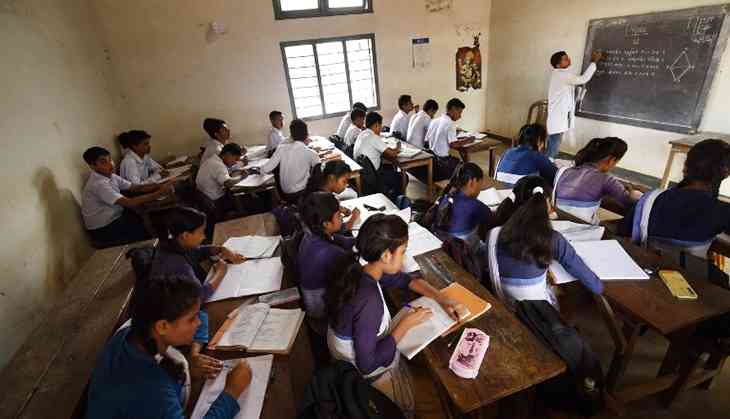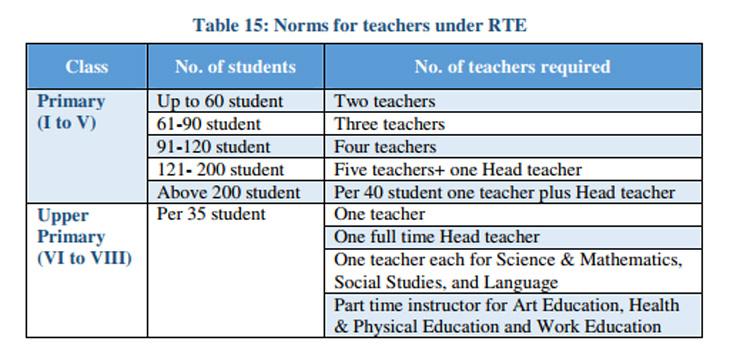India's schools just don't have enough teachers: CAG report

The current challenge when it comes to school education in India remains that of quantity and quality for its primary systems.
The recent report by the Comptroller and Auditor General (CAG) on the Right of Children to Free and Compulsory Education Act, 2009, known at the RTE Act, was tabled in Parliament last week, confirmed many irregularities in its implementation.
One of the biggest defects of the RTE Act revealed in the CAG report is that the Pupil Teacher Ratio (PTR), which are ideally required to be 30:1 in primary schools (PS) and 35:1 in upper primary schools (UPS), is abysmal in 11 states.
Section 25 of Act had stated that within three years (31 March 2013) from the date of commencement of this Act, the appropriate government and the local authority should ensure that the PTR is maintained in each government school.
According to the Act, the norms are as follows:

The reality on the ground though is very different. Even though RTE norms clearly prohibit single teacher schools, the CAG report observed thousands of cases of schools being run by single teachers.
The state that have failed to comply with the Act are:
Bihar:
According to the report, the PTR in both PS and UPS schools was in the range of 50:1 and 61:1 between 2010 and 2016. Moreover, 3,269 PSs (8%) and 127 UPSs (1%) were running with single teacher in Bihar during 2015-16.
Gujarat:
In Gujarat, 64 schools with a total of 5,698 students had no teachers during 2013-14 and 677 schools had only one teacher as of March 2016.
On the other side there were 843 and 7,333 surplus teachers in 1,539 PSs and 4,243 UPs respectively as of March 2016.
The report also added that no efforts were made by the director of primary education for rational deployment of teachers.
Chhattisgarh:
In Chhattisgarh, the report observed both adverse and surplus PTR. In 2015-16, out of 30,919 PSs and 13,408 UPSs, in 4,362 PSs and 2,112 UPSs there was adverse PTR and in 13,947 PSs and 8,227 UPSs, there was surplus PTR.
On being pointed out, the state’s education department stated that action would be taken as per the provision of the Act. However, the report says the department failed to correct the deployment of teachers.
Madhya Pradesh:
In Madhya Pradesh, the report revealed that upto 48,132 PSs and 15,107 UPSs had adverse PTR during 2010-16 time period.
However, in some test checked districts, 2,925 teachers and 729 head teachers were working in excess in 2,444 PSs against the requirement as per the RTE Act and 751 teachers and 621 full time head teachers were working in excess in 886 UPSs. 17,938 (15%) to 20,245 (18%) schools were working with single teachers during 2010-2016.
In eight districts, there were no teachers whatsoever in 1,329 PSs and UPSs. Against the requirement of three teachers, two teachers were available in 7,269 (24%) (2013-14) to 7,937 (26%) (2015-16) UPSs.
Andhra Pradesh:
5,282 PSs (15%) and 35 UPSs (0.67 %) had single teachers as of 31 March 2016 and further, there were 1,928 PSs (5.5 %) and 829 UPSs (16%) with adverse PTR.
Haryana:
In Haryana, the report says that there are 788 PSs (8.86%) and 269 UPSs (4.79 %) running with single teachers in 2015-16.
Odisha:
In all, 2,023 (3.4%) schools were functioning in the state with single teacher during 2015-16. In sampled districts, the Audit noted that 85 schools with 2,379 students (2015- 16), were functioning with a single teacher against the norm of two to three teachers.
Punjab:
There were 1,406 PSs (10.78 %) and 228 UPSs (3.61 %) running with a single teacher.
Rajasthan:
Overall, 11,071 PSs (29%) and 365 UPSs (2%) were running with single teacher in 2015-16.
Tamil Nadu:
The report says that there were 197 (2.39 %) single teacher schools in 154 government schools during 2015-16.
Meghalaya:
Scrutiny of records of the State Project Director, State Education Mission Authority Meghalaya (SEMAM) during 2010-16 revealed a favourable PTR ratio. However, 224 single teacher schools reflects irrational deployment of teachers as of 31 March 2016.
Improper implementation
As of 2016, according to the government, there were 9 lakh vacancies for teachers in government schools across the country. After the enactment of the RTE in 2010, there were two deadlines set by the government to implement the Act.
One was for the fulfillment of the requirement of teachers’ recruitment by March 2013. More so, 2015 was the deadline for the regularisation and training of all teachers.
However, neither of these requirements have not been fulfilled as of now.
The Sarva Shiksha Abhiyan (SSA), which is responsible for the implementation of the RTE Act, had asked for the deadline for these requirements to be extended till March 2019. On 20 July, the Parliament agreed to extend the deadline till 2019.
RTE National convenor Ambarish Rai told Catch, “The fact of the matter is that not enough resources are being utilised for school education in the country. We are investing just about 3% of our GDP on education and even lesser for school education. There aren’t enough resources to hire qualified teachers for government schools. The norms of the RTE are very minimal in comparison to other countries. Even these norms are not being adhered to.”
He added, “The current state of PTR is horrible in the country. Untrained teachers are hired on contractual basis for very low salaries. In all, 5 lakh contractual teachers are untrained, which is a clear violation of the RTE Act. More so, 10% of schools in the country are single teacher schools out of 1.5 million government schools. Recruitment of quality teachers is not happening because state governments do not have the resources. All recruitment should have happened by 2013. Educational financing is inadequate, and the funds that are allocated are unutilised."
RTE activist Annie Namla told Catch, "Qualified teachers prefer to seek employment in private schools over government schools because government schools fail to pay proper salaries. Apart from that, the deployment of teachers in the district level is not free of corruption and bribery. Also, the SSA is more focused towards the educational content and programmes as opposed to administration and implementation. Block education officers and district education officers have the bulk of responsibility towards implementation of RTE norms which they are obviously not equipped to do properly.”
First published: 27 July 2017, 19:31 IST

